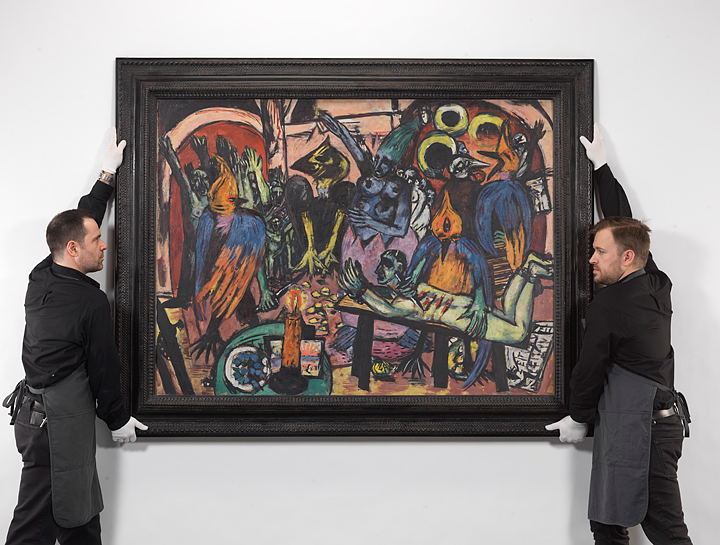
Aided by strong Asian bidding and a record for Max Beckmann, Christie’s inched ahead of Sotheby’s with a £149.5 million ($190 million) Impressionist and Modern sale in London this evening.
The respectable total put an end to Christie’s long run of declining June sales, which hit a low last year with a dismal £25.6 million result. By contrast, tonight’s sale was the highest total for a Christie’s London June Impressionist auction since its £153 million sale in 2010.
Although the evening’s total was on the lower end of the £141.3–191.7 million pre-sale estimate, Christie’s managed to eke out a victory over Sotheby’s equivalent sale last week by just £500,000. An impressive 30 of the 32 lots offered were sold, even if half of those lots fetched prices at or below their low estimates.
The big-ticket item was Beckmann’s Birds’ Hell (1937–8), a painting with a museum exhibition history as long as any from the period. Most recently, Beckmann’s image of the horrors of the Nazi regime was included in the Metropolitan Museum of Art’s show “Max Beckmann in New York,” which closed in February.
The work drew three bidders, including the guarantor, but ultimately sold without much of a fight to Larry Gagosian for a record £36 million ($45.8 million). The word in the trade is that he was bidding for the major New York collector Leon Black. The painting was one of four works guaranteed in the sale and carried an estimate in the range of £30 million. (Final prices include the buyer’s premium; pre-sale estimates do not.)
I first saw the Expressionist painting at the Royal Academy in London in 1985; it was on loan from the dealer Richard Feigen, who had acquired it two years earlier. It has remained in his collection until now (although it was described by Christie’s simply as “Property from a Private American Collection”). The previous record for Beckmann, $22.6 million, was also set by Feigen in 2001, when he bought Self-Portrait with Horn (1938) for Ronald Lauder’s Neue Galerie in New York.
Meanwhile, another Expressionist work was the night’s biggest flop. Among the highest valued lots of the evening, Egon Schiele’s rather somber, square-shaped painting Individual Houses (with Mountains) (1915) failed to attract a single bid (pre-sale estimate: £20–30 million).
Pablo Picasso’s Femme écrivant (Marie-Thérèse) (1934). Courtesy of Christie’s.
The sale’s second highest-selling lot was Pablo Picasso’s portrait of Marie-Thérèse Walter, Femme écrivant (Marie-Thérèse) (1934), which attracted a guarantee just hours before the sale. Unusually, its estimate also rose at the last minute, from £25–40 million to £30–40 million. The tender, sensual image is the kind that would appeal both to longtime Picasso collectors like casino magnate Steve Wynn and the new brand of Asian collector. It proved a savvy deal for the guarantor, selling to a Chinese buyer for £34.9 million ($44.4 million).
There was notable bidding from Asia throughout the sale, with six of the top ten lots attracting Asian bidding and buying. These included Vincent van Gogh’s vivid Le Moissonneur (d’après Millet) (1889), which was guaranteed (and carried a pre-sale estimate of £12.5–16.5 million). It was chased by bidders from Spain and China, as well as the Belgian art advisor Alex Brontmann, but eventually sold to an American phone bidder for £24.2 million ($30.9 million). The seller, a European collector who bought the painting in 1995 for £2.5 million, made a tidy profit: £22 million in 22 years.
Vincent van Gogh’s Le Moissonneur (d’après Millet) (1889). Courtesy of Christie’s.
There was also significant Asian bidding on works by Chagall, Matisse, Degas, Picasso, and Monet. Monet’s Weeping Willow (1918–19) sold to a Chinese bidder for £8.9 million, half its £15–25 million estimate. Four Asian bidders also fought for Monet’s idyllic, more decorative Le Chemin Creux (1882), before it eventually sold to Elaine Holt of Christie’s Hong Kong for £5.6 million, double its estimate of £2–3 million.
Monet’s Weeping Willow (1918–1919). Courtesy of Christie’s.
Among the top-estimated lots of the evening, Modigliani’s Cariatide (1913) has a high-profile recent history that was not divulged in the catalogue. The painting (pre-sale estimate: £6–9 million) has belonged for the past decade to British financier Michael Spencer, the former Treasurer of the Conservative party. (He bought it from another art-loving financier, Samir Traboulsi.)
During the credit crunch, Spencer leveraged the painting to borrow money from Sotheby’s Financial Services Department, and in 2009, he offered it for sale at the auction house. It bombed, like most art at that time, passing at £4.5 million.
It was interesting so see it re-emerge at Christie’s with a request that the buyer lend it to New York’s Jewish Museum and London’s Tate for a forthcoming Modigliani show. The London Russian art specialist James Butterwick bought the painting for a client for £6.9 million, at the low end of the estimate.
Beyond the Beckmann, the evening minted a number of new artist records, including for the Belgian de Stijl artist Georges Vantongerloo, whose Mondrian-style grid composition sold for £1.1 million, double its pre-sale estimate of £350,000–450,000. A rare painting by the Dada artist Hannah Höch, better known for her stylish photo collages, sold above estimate for a record £1.1 million after a phone bidder outbid advisor Matthew Stephenson.
Georges Vantongerloo’s Composition dans le carré avec couleurs jaune-vert-bleu-indigo-orangé (1930). Courtesy of Christie’s.
The oddest element of the sale was the house’s decision to include one work each by the Italian Arte Povera artist Lucio Fontana and the Canadian painter Jean-Paul Riopelle, who died in 2002. Both would normally be in a postwar and contemporary art sale, but “the boundaries are changing,” said Christie’s Global President Jussi Pylkkanen after the sale. Significantly, the Nahmad family of collectors and dealers, who are equally active in the Impressionist, Modern, and postwar markets, underbid on works by both artists, which sold for prices in the middle of their estimates.
The week’s action continues tomorrow evening at Sotheby’s postwar and contemporary sale.